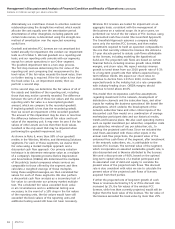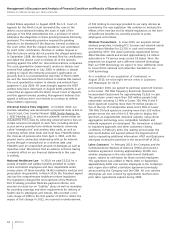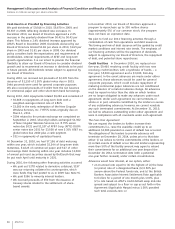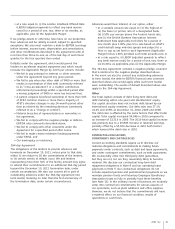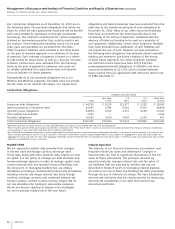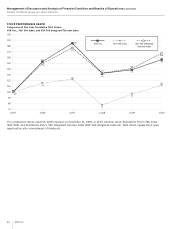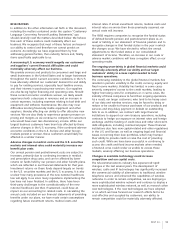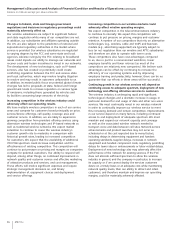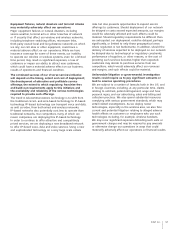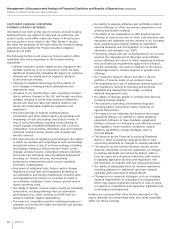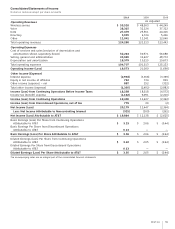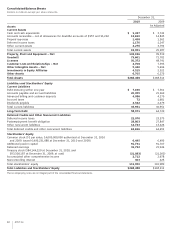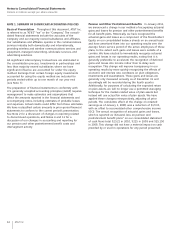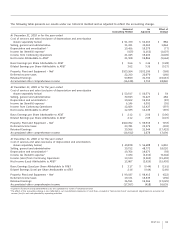AT&T Wireless 2010 Annual Report Download - page 58
Download and view the complete annual report
Please find page 58 of the 2010 AT&T Wireless annual report below. You can navigate through the pages in the report by either clicking on the pages listed below, or by using the keyword search tool below to find specific information within the annual report.
Management’s Discussion and Analysis of Financial Condition and Results of Operations (continued)
Dollars in millions except per share amounts
56 AT&T Inc.
Increasing competition in our wireline markets could
adversely affect wireline operating margins.
We expect competition in the telecommunications industry
to continue to intensify. We expect this competition will
continue to put pressure on pricing, margins and customer
retention. A number of our competitors that rely on alternative
technologies (e.g., wireless, cable and VoIP) and business
models (e.g., advertising-supported) are typically subject to
less (or no) regulation than our wireline and ATTC subsidiaries
and therefore are able to operate with lower costs.
These competitors also have cost advantages compared
to us, due in part to a nonunionized workforce, lower
employee benefits and fewer retirees (as most of the
competitors are relatively new companies). We believe such
advantages can be offset by continuing to increase the
efficiency of our operating systems and by improving
employee training and productivity; however, there can be no
guarantee that our efforts in these areas will be successful.
Continuing growth in our wireless services will depend on
continuing access to adequate spectrum, deployment of new
technology and offering attractive services to customers.
The wireless industry is undergoing rapid and significant
technological changes and a dramatic increase in usage, in
particular demand for and usage of data and other non-voice
services. We must continually invest in our wireless network
in order to continually improve our wireless service to meet
this increasing demand and remain competitive. Improvements
in our service depend on many factors, including continued
access to and deployment of adequate spectrum. We must
maintain and expand our network capacity and coverage
as well as the associated wireline network needed to
transport voice and data between cell sites. Network service
enhancements and product launches may not occur as
scheduled or at the cost expected due to many factors,
including delays in determining equipment and handset
operating standards, supplier delays, increases in network
equipment and handset component costs, regulatory permitting
delays for tower sites or enhancements or labor-related delays.
Deployment of new technology also may adversely affect the
performance of the network for existing services. If the FCC
does not allocate sufficient spectrum to allow the wireless
industry in general, and the company in particular, to increase
its capacity or if we cannot deploy the services customers
desire on a timely basis or at adequate cost while maintaining
network quality levels, then our ability to attract and retain
customers, and therefore maintain and improve our operating
margins, could be materially adversely affected.
Changes to federal, state and foreign government
regulations and decisions in regulatory proceedings could
materially adversely affect us.
Our wireline subsidiaries are subject to significant federal
and state regulation while many of our competitors are not.
In addition, our subsidiaries and affiliates operating outside
the U.S. are also subject to the jurisdiction of national and
supranational regulatory authorities in the market where
service is provided. Our wireless subsidiaries are regulated
to varying degrees by the FCC and some state and local
agencies. Adverse rulings by the FCC relating to broadband
issues could impede our ability to manage our networks and
recover costs and lessen incentives to invest in our networks.
The development of new technologies, such as IP-based
services, also has created or potentially could create
conflicting regulation between the FCC and various state
and local authorities, which may involve lengthy litigation
to resolve and may result in outcomes unfavorable to us.
In addition, increased public focus on potential global climate
changes has led to proposals at state, federal and foreign
government levels to increase regulation on various types
of emissions, including those generated by vehicles and
by facilities consuming large amounts of electricity.
Increasing competition in the wireless industry could
adversely affect our operating results.
We have multiple wireless competitors in each of our service
areas and compete for customers based principally on price,
service/device offerings, call quality, coverage area and
customer service. In addition, we are likely to experience
growing competition from providers offering services using
alternative wireless technologies and IP-based networks as
well as traditional wireline networks. We expect market
saturation to continue to cause the wireless industry’s
customer growth rate to moderate in comparison with
historical growth rates, leading to increased competition
for customers. We expect that the availability of additional
700 MHz spectrum could increase competition and the
effectiveness of existing competition. This competition will
continue to put pressure on pricing and margins as companies
compete for potential customers. Our ability to respond will
depend, among other things, on continued improvement in
network quality and customer service and effective marketing
of attractive products and services, and cost management.
These efforts will involve significant expenses and require
strategic management decisions on, and timely
implementation of, equipment choices and deployment,
and service offerings.


